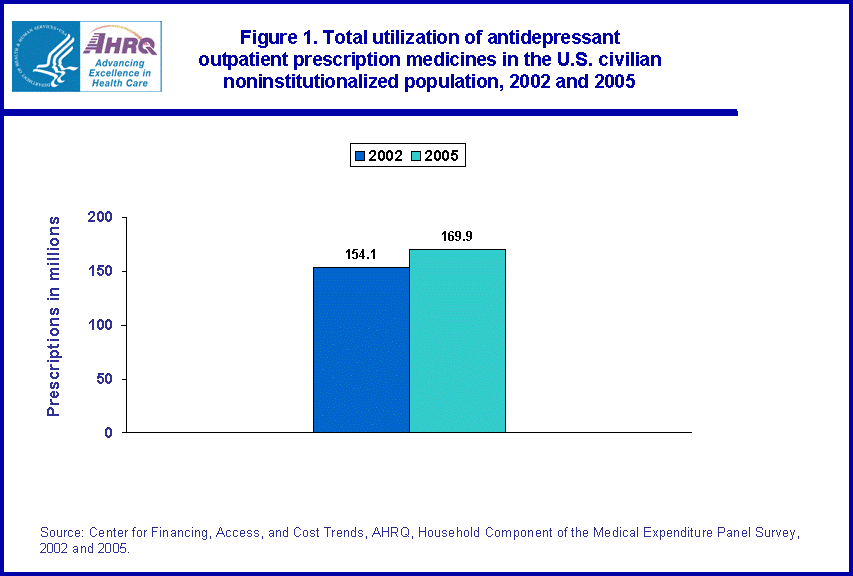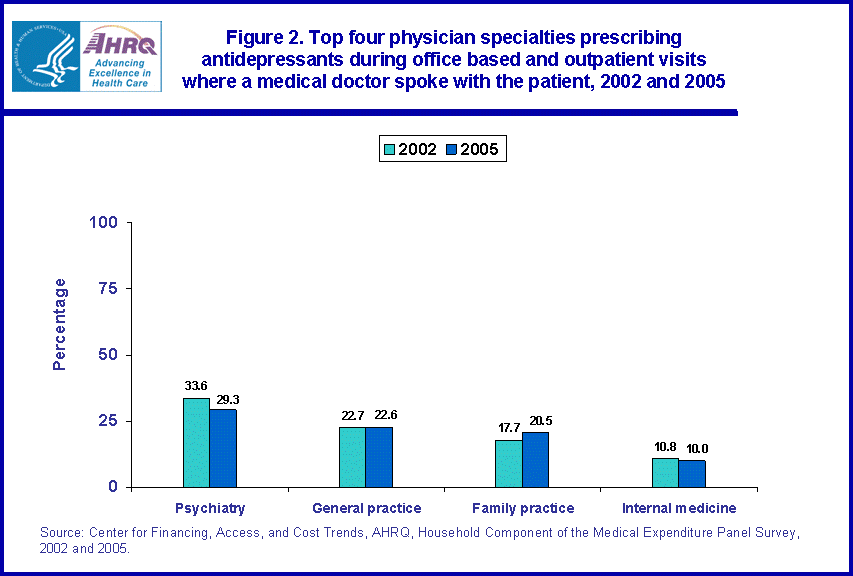
|
|
Font Size:
|
||||
|
|
|
|
||||
STATISTICAL BRIEF #206:
Antidepressants Prescribed by Medical Doctors in Office Based and Outpatient Settings by Specialty for the U.S. Civilian Noninstitutionalized Population, 2002 and 2005
Highlights
- In 2002, there were 154.1 million antidepressant prescription purchases in the U.S. civilian noninstitutionalized population, and by 2005, rose to 169.9 million antidepressant purchases.
- During 2005, the highest percentage of antidepressant prescriptions written during office based and outpatient visits where a medical doctor spoke with the patient were written by psychiatrists (29.3 percent).
- In 2005, the top four specialties of doctors writing antidepressant prescriptions during outpatient and office based visits where a medical doctor spoke with the patient were psychiatry (29.3 percent), general practice (22.6 percent), family practice (20.5 percent), and internal medicine (10.0 percent).
- When comparing 2002 and 2005, medical doctors with a specialty in psychiatry prescribed a higher percentage of antidepressant prescriptions during office based and outpatient visits where a medical doctor spoke with the patient in 2002 (33.6 percent) than in 2005 (29.3 percent).
Introduction
This Statistical Brief provides information as reported by households in the U.S. civilian noninstitutionalized population on total utilization of outpatient antidepressant prescription medicines in 2002 and 2005. The brief also provides, by medical doctor specialty, estimates as reported by households on the percentage of prescriptions (not including refills) of antidepressants prescribed during office based and outpatient visits where a medical doctor spoke with the patient either in person or over the telephone for the years 2002 and 2005.
The estimates in this brief are derived from the Household Component of the 2002 and 2005 Medical Expenditure Panel Survey (MEPS-HC). In the MEPS-HC, the medical doctor specialty question was only asked in regards to office based and outpatient visits where a medical doctor either saw and spoke to the patient in person, or spoke to the patient over the telephone. Consequently, to obtain the medical doctor specialty percentages, the data were subcategorized to prescriptions (not including refills) of antidepressant prescribed medication purchases that were mentioned in relation to office based and outpatient visits where a medical doctor spoke with the patient. However, in MEPS, a respondent can report speaking with more than one doctor per visit, and can also report a prescribed medicine in relation to one or more outpatient or office based medical events. If more than one type of doctor specialty was reported in these examples, each specialty was included in the estimates.
Only prescribed medicine purchases in an outpatient setting are included in the MEPS-HC estimates. Prescription medicines administered in an inpatient setting or in a clinic or medical doctor's office are excluded from these estimates.
Antidepressant classification was assigned to MEPS prescribed medicines using Multum Lexicon variables from Cerner Multum, Inc.
All differences discussed in the text are statistically significant at the 0.05 level.
Findings
In 2002, there were 154.1 million household reported purchases for antidepressant outpatient prescription medicine in the U.S. community population, and by 2005, that number rose to 169.9 million prescriptions (figure 1).
In 2005, 53.0 million antidepressant prescriptions were prescribed during visits where a medical doctor spoke with the patient. The top four household reported medical doctor specialties included the following: psychiatry (29.3 percent), general practice (22.6 percent), family practice (20.5 percent), and internal medicine (10.0 percent) (figure 2).
Of the antidepressants prescribed by medical doctors in office based and outpatient settings, where a medical doctor spoke with the patient in 2005, the percentage written by doctors with a specialty in psychiatry was about 30 percent (29.3 percent) and was higher than the percentage prescribed by the remaining specialties in the top four (general practice, 22.6 percent; family practice, 20.5 percent; and internal medicine, 10.0 percent). There was no difference in the percentage of antidepressants prescribed by physicians with specialties in general practice or family practice (22.6 percent and 20.5 percent, respectively), and those specialties prescribed a higher percentage of antidepressants than those medical doctors with a specialty in internal medicine (10.0 percent) (figure 2).
When comparing 2002 and 2005, the percentage of the antidepressants prescribed by medical doctors with a specialty in psychiatry in office based and outpatient settings where a medical doctor spoke with the patient decreased from 33.6 percent to 29.3 percent. The percentages for all other specialties in the top four that prescribed antidepressants remained stable when 2002 was compared with 2005 (general practice, 22.7 percent versus 22.6 percent; family practice, 17.7 percent versus 20.5 percent; and internal medicine 10.8 versus 10.0 percent) (figure 2).
Data Source
The data sources used were MEPS HC-067A: 2002 Prescribed Medicines File, MEPS HC-070: 2002 Full Year Consolidated Data File, MEPS HC-094A: 2005 Prescribed Medicines File, and MEPS HC-097: 2005 Full Year Consolidated Data File.
Definitions/Methodology
Therapeutic Classifications
The antidepressant classification assigned to MEPS prescribed medicines using Multum Lexicon variables from Cerner Multum, Inc., MEPS prescribed medicines files were linked to the Multum Lexicon database to obtain therapeutic class and subclass variables. All antidepressants in MEPS were defined as those events assigned the therapeutic subclass (TC1S1=249) in the Multum Lexicon database. For additional information on these and other Multum Lexicon variables, as well as the Multum Lexicon database itself, please refer to the following Web site: http://www.multum.com/Lexicon.htm.
Medical Doctor Specialty
MEPS prescribed drug data were categorized to all outpatient prescribed antidepressant medications purchased by the U.S. civilian noninstitutionalized population. To obtain the specialty of doctor data, the data were further subcategorized to only those antidepressant prescribed medications that were reported by household respondents as prescribed during office based or outpatient visits where a medical doctor spoke with the patient. In MEPS, the medical doctor specialty question is asked only for office based or outpatient visits where a medical doctor spoke with the patient. Speaking with a medical doctor includes seeing and speaking to a medical doctor during a visit or speaking to a medical doctor over the telephone.
In MEPS, a respondent is able to report seeing more than one doctor per visit and a respondent can also report a prescribed medicine in regards to one or more outpatient or office based medical event. When these situations occurred and more than one doctor specialty was reported, each specialty was included in the estimates.
Utilization
Utilization was defined as one or more household reported purchases of a prescribed antidepressant. Refills as well as original prescriptions are included in the total utilization counts. However, in the physician specialty estimates refills are not included.
About MEPS-HC
MEPS-HC is a nationally representative longitudinal survey that collects detailed information on health care utilization and expenditures, health insurance, and health status, as well as a wide variety of social, demographic, and economic characteristics for the civilian noninstitutionalized population. It is cosponsored by the Agency for Healthcare Research and Quality and the National Center for Health Statistics.
For more information about MEPS, call the MEPS information coordinator at AHRQ (301-427-1656) or visit the MEPS Web site at http://www.meps.ahrq.gov/.
References
For a detailed description of the MEPS-HC survey design, sample design, and methods used to minimize sources of nonsampling error, see the following publications:
Cohen, J. Design and Methods of the Medical Expenditure Panel Survey Household Component. MEPS Methodology Report No. 1. AHCPR Pub. No. 97-0026. Rockville, MD: Agency for Health Care Policy and Research, 1997. http://www.meps.ahrq.gov/mepsweb/data_files/publications/mr1/mr1.shtml
Cohen, S. Sample Design of the 1996 Medical Expenditure Panel Survey Household Component. MEPS Methodology Report No. 2. AHCPR Pub. No. 97-0027. Rockville, MD: Agency for Health Care Policy and Research, 1997. http://www.meps.ahrq.gov/mepsweb/data_files/publications/mr2/mr2.shtml
Cohen, S. Design Strategies and Innovations in the Medical Expenditure Panel Survey. Medical Care, July 2003: 41(7) Supplement: III-5-III-12.
Ezzati-Rice, TM, Rohde, F, Greenblatt, J, Sample Design of the Medical Expenditure Panel Survey Household Component, 1998-2007. Methodology Report No. 22. March 2008. Agency for Healthcare Research and Quality, Rockville, MD. http://www.meps.ahrq.gov/mepsweb/data_files/publications/mr22/mr22.pdf
Suggested Citation
Stagnitti, M. N. Antidepressants Prescribed By Medical Doctors in Office Based and Outpatient Settings by Specialty for the U.S. Civilian Noninstitutionalized Population, 2002 and 2005. Statistical Brief #206. June 2008. Agency for Healthcare Research and Quality, Rockville, MD. http://www.meps.ahrq.gov/mepsweb/data_files/publications/st206/stat206.pdf
AHRQ welcomes questions and comments from readers of this publication who are interested in obtaining more information about access, cost, use, financing, and quality of health care in the United States. We also invite you to tell us how you are using this Statistical Brief and other MEPS data and tools and to share suggestions on how MEPS products might be enhanced to further meet your needs. Please e-mail us at mepspd@ahrq.gov or send a letter to the address below:
Steven B. Cohen, PhD, Director
Center for Financing, Access, and Cost Trends
Agency for Healthcare Research and Quality
540 Gaither Road
Rockville, MD 20850
 |
|||||||||||||||||||||||||
|
|||||||||||||||||||||||||
|
|
|||||||||||||||||||||||||
 |
|||||||||||||||||||||||||
|
|||||||||||||||||||||||||
|
|
|||||||||||||||||||||||||


